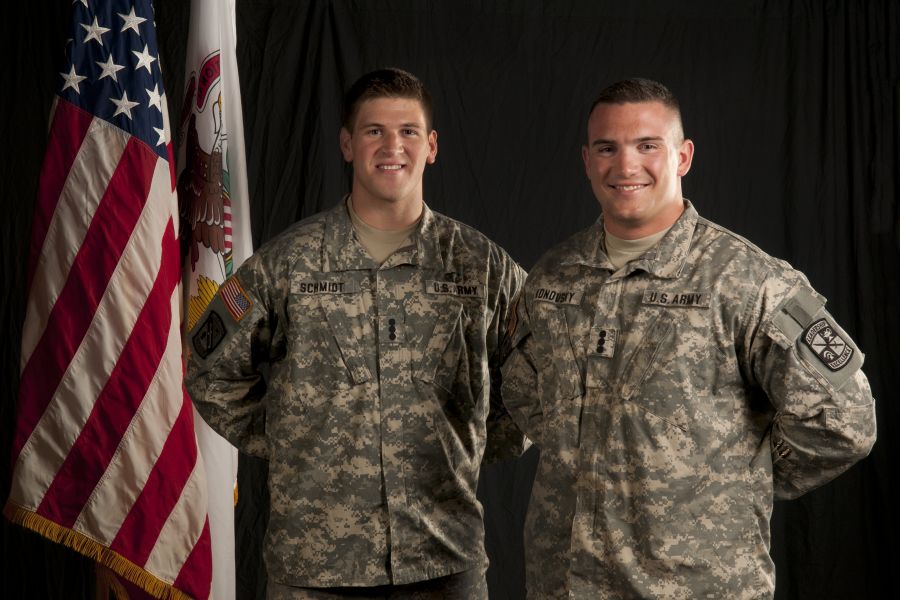College is hard enough. Now add in grueling daily physical training at 6 a.m., a weekly 4-mile “Ruck March” in full gear down Constitution Trail, special leadership lab sessions, and extracurricular activities with imposing names like “Ranger Challenge” and “Rifle Team.”
That’s what Stephen Schmidt and Will Konovsky have done as Reserve Officers’ Training Corps (ROTC) cadets at Illinois State. It was tough but worth it, they said, and now that hard work pays off. They’re two of 11 ROTC cadets graduating this week, and like any two students at Commencement they’re starting from the same place but going in different directions.
Schmidt is heading off to a nine-year active duty stint as an Army aviation officer, and Konovsky is looking for a civilian police job between weekends with the Illinois National Guard.
“It’s a little overwhelming. I think I’m more worried about graduating than I am about committing nine years of my life,” Schmidt told STATEside. “But I’m looking forward to it honestly. I can’t wait to start learning new things—and fly cool stuff.”
Both students joined ROTC their freshman year, but for different reasons. Schmidt didn’t really like college after his first semester, but he found his niche with ROTC after his father (an Army veteran himself) told him to stick with it and get his degree. Konovsky, originally a football recruit, was approached by a military recruiter at Preview, and ended up joining ROTC and the Guard at the same time.
Illinois State has 80 enrolled ROTC cadets, in addition to hundreds of veterans and non-ROTC citizen-soldiers on campus. Those ROTC cadets are a tight-knit group, and together they face a demanding—but rewarding—weekly schedule, including the 6-7:30 a.m. physical training (PT) sessions every Monday, Wednesday, and Friday.
The ROTC program kicks into high gear during a student’s junior year, with many cadets committing to their service contracts, carrying full class loads, and preparing for the all-important, 29-day Leadership Development and Assessment Course (LDAC) the summer before senior year at Fort Lewis, Washington.
“It’s a stressful year,” said Konovsky, a Naperville native. “You’re really under the microscope.”
But at the end of the road are some serious benefits, including several scholarship opportunities (active duty or Guard) and other financial compensation. A lot of prospective recruits don’t realize that they can join both the ROTC and the Guard through the Simultaneous Membership Program (SMP), which pays them for ROTC training and guarantees they won’t be deployed while in school, Konovsky said.
That’s what Konovsky did, and he’s now serving with the Bloomington-based 33rd Military Police Battalion Guard unit. Now, as he becomes an officer, he’s committing to six more years in the Guard.
“They really set you up for success,” said Schmidt, a graphic communications major from Atlanta, Illinois.
Schmidt will be a full-blown active duty pilot, reporting to Basic Officer Leadership Course at Fort Rucker, Alabama, in January 2014. He caught the aviation bug early, went skydiving at age 18, and then trained at a two-week military jump school between his sophomore and junior years at ISU.
“Ever since I jumped out of a plane, I wanted to be a pilot,” said Schmidt, who may someday look to turn his military training into a job flying medical transport helicopters.
While Schmidt begins his training, Konovsky will be starting his civilian career. The criminal justice sciences major—the son of a firefighter—did an internship with the Bloomington Police Department and is now job hunting. It’s not the easiest job market right now for police work, Konovsky says, but he feels that his ROTC and Guard background shows employers he’s trustworthy and hard-working.
“It’s definitely helped me rise to the top, compared to my peers,” Konovsky said. “Employers understand that being a lieutenant in the military is not an easy thing to get. The amount of time you put into it carries a lot (of weight).”
Ryan Denham can be reached at rmdenha@IllinoisState.edu.


One thought on “Different paths for 2 Illinois State ROTC graduates”